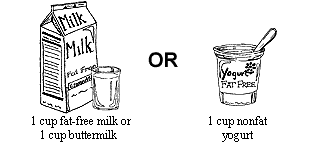|

Instructions:
Contents:
How much you should eat depends on
- Whether you are a man or woman.
- How much you weigh.
- How tall you are.
- Your age.
- How much you exercise.
- The type of work or other activity you do every day.
- If you are pregnant or breastfeeding.
- Measuring cups.
- Measuring spoons.
- A food scale.
- The Nutrition Facts labels on food packages help you
learn how much food is in one serving.

Seven food groups make up the food pyramid. The food pyramid
helps you decide how many servings of each food group to
eat. It shows that you should eat the most servings from
the starches, vegetables, and fruits—the largest sections
of the food pyramid. You should eat small amounts from the
sugary foods and fats and oils sections of the pyramid.
How Many Servings of Starches Should I Eat?
The grains, cereal, rice, pasta, and starchy vegetables group
is the largest part of the food pyramid.
Examples of one serving of food from this group are

Do you eat starches that are not listed? Ask your diabetes
teacher how much and how often to eat them. Also ask the
healthiest ways to eat them.
Remember, you might need more than one serving at a meal.
If you need two servings, eat double the amount or eat one
serving each of two starches.
 |
| Every time you eat foods like
dry cereal, hot cereal, pasta, or rice, use
the same type of bowl or plate. Measure the
correct serving with a measuring tool.
When you eat the food again,
fill the bowl to the same level. Use a measuring
tool to measure foods once in a while to make
sure your servings are still correct.
|
|
How Many Servings of Vegetables Should I Eat?
Vegetables are in the next level of the food pyramid.
Examples of one serving of food from the vegetable group
are

Do you eat vegetables that are not listed? Ask your diabetes
teacher how much and how often to eat them. Also ask the
healthiest ways to eat them.
Remember, you might need more than one serving at a meal.
If you need two servings, eat double the amount or eat one
serving each of two vegetables.
 |
| If you buy fresh vegetables,
buy the vegetables you like in the serving size
you should eat. For example, buy small tomatoes
or small squashes. If you buy vegetables in
servings that are larger than you need, you
might eat too much. |
|
How Many Servings of Fruit Should I Eat?
Fruits are on the same level of the food pyramid as the vegetable
group.
Examples of one serving of food from the fruit group are

Do you eat fruits that are not listed?
Ask your diabetes teacher how much and how often to eat
them. Also ask the healthiest ways to eat them.
Remember, you might need more than one serving at a meal.
If you need two servings, eat double the amount or eat one
serving each of two fruits.
 |
| If you buy fresh fruits, buy
small to medium pieces. If the pieces of fruit
you buy are too big, you might eat too much.
|
|
How Many Servings of Milk and Yogurt Should I Eat?
Milk and yogurt are on the next level of the food pyramid.
One serving of food from the milk and yogurt group is

Do you eat milk and yogurt-type foods that are not listed?
Ask your diabetes teacher how much and how often to eat
them. Also ask the healthiest ways to eat them.
 |
| Always drink milk out of the
same size of glass. Fill a 1-cup measuring cup
with milk. Pour the milk into your glass. See
how high it fills the glass.
Measure the amount of milk
in a measuring cup once in a while to make
sure your servings are still correct.
|
|
How Many Servings of Protein Foods Should I Eat?
Protein foods are on the same level of the food pyramid as
milk and yogurt.
Examples of one serving (about 2 to 3 ounces) of food from
the protein food group are

Do you eat protein foods that are not listed?
Ask your diabetes teacher how much and how often to eat
them. Also, ask the healthiest ways to eat them.
 |
| If you cannot weigh the food,
make sure the serving is about the size and
thickness of the palm of your hand or a deck
of cards.
Remember, meats weigh more
before they are cooked. For example: 4 ounces
of raw meat weighs 3 ounces after cooking.
If the meat has bone, like a pork chop or
a chicken leg, then cook 5 ounces raw to get
3 ounces cooked.
|
|
How Many Servings of Fats and Oils Should I Eat?
Fats and oils are part of the smallest section of the food
pyramid. This means you should eat fats and oils only in small
amounts.
Examples of one serving of fats and oils are

Do you eat fats or oils that are not listed?
Ask your diabetes teacher how much and how often to eat
them. Also ask the healthiest way to eat them.
 |
| Use measuring spoons to learn
how much fat or oil to use. Then, when you do
not have measuring spoons, like in a restaurant,
you will know how much to use. It is easy to
eat too much fat and oil. |
|
How Many Servings of Sugary Foods Should I Eat?
Sugary foods are part of the smallest section of the food
pyramid. This means you should eat sugary foods only once
in a while.
Examples of one serving of sugary foods and sweets are

Do you eat sugary foods that are not listed? Ask your diabetes
teacher how much and how often to eat them. Also ask the
healthiest ways to eat them.
 |
Here are ways to eat small portions
of sugary foods:
- Split and share desserts
in restaurants.
- Order small or child-size
servings of ice cream or frozen yogurt.
- Divide homemade desserts
into small servings and wrap each piece separately.
Freeze the extra servings.
- Do not have candy dishes
around the house or near you at work.
|
|
Points To Remember
To follow a healthy eating plan
- Eat the right number of servings of food from each of
the food groups.
- Eat these foods in the right amounts.
- Use your measuring tools.
- Choose foods in the proper serving size when you shop.
How To Find More Help
 Diabetes
Teachers Diabetes
Teachers
(nurses, dietitians, pharmacists, and other health professionals)
- To find a diabetes teacher near you, call the American
Association of Diabetes Educators toll-free at 1-800-TEAMUP4
(1-800-832-6874).
Recognized Diabetes Education Programs
(teaching programs approved by the American Diabetes Association)
- To find a program near you, call 1-800-DIABETES (1-800-342-2383)
or look at its Internet home page <http://www.diabetes.org>
and click on "Diabetes Info."
Dietitians
- To find a dietitian near you, call The American Dietetic
Association's National Center for Nutrition and Dietetics
at 1-800-366-1655 or look at its Internet home page <http://www.eatright.org>
and click on "Find a Dietitian."
Acknowledgments
The individuals listed here provided editorial guidance or
facilitated field testing for this publication. The National
Diabetes Information Clearinghouse would like to thank these
individuals for their contributions.
American Association
of Diabetes Educators
Chicago, IL
Shelly Amos, L.R.D. Nez Percé Nutrition
Lapwai, ID
Noreen Cohen, M.S., R.D., L.D.
Humana Health Care Plans
San Antonio, TX
Paula Dubcak, R.N., C.D.E.
Humana Health Care Plans
San Antonio, TX
Lois Exelbert, R.N., M.S., C.D.E.,
A.C.C.E.
Joslin Center for Diabetes
Baptist Hospital of Miami
Miami, FL
|
Ruth Farkas-Hirsch,
R.N., M.S., C.D.E.
(on behalf of American Diabetes Association)
University of Washington,
Diabetes Care Center
Seattle, WA
Lawana Geren, R.N., C.D.E.
Humana Health Care Plans
San Antonio, TX
Gwen Hosey, M.S., A.N.P., C.D.E.
IHS Portland Area Diabetes Program at Washington
Bellingham, WA
Joslin Center for Diabetes
Community Medical Center
Toms River, NJ
Melinda Maryniuk, M.Ed., R.D., C.D.E.
Joslin Diabetes Center
Boston, MA
|
Pat Mathis,
M.S., R.N., C.D.E.
Marianne Sack, R.N., C.D.E.
So Others Might Eat
Washington, DC
Kathy O'Keeffe, M.S., R.D., L.D.,
C.D.E.
Carolina Diabetes and Kidney Center
Sumter, SC
Carolyn Ross, R.D., M.S., C.D.E.
PHS Indian Hospital
Cass Lake, MN
Lisa Spence, M.S.
Purdue University
West Lafayette, IN
Judy Tomassene, M.P.H., M.S., R.D.
Seattle Indian Health Board
Seattle, WA
Madelyn L. Wheeler, M.S., R.D., F.A.D.A.,
C.D.E.
Indiana University School of Medicine
Diabetes Research and Training Center
Indianapolis, IN
|
National Diabetes Information Clearinghouse
|